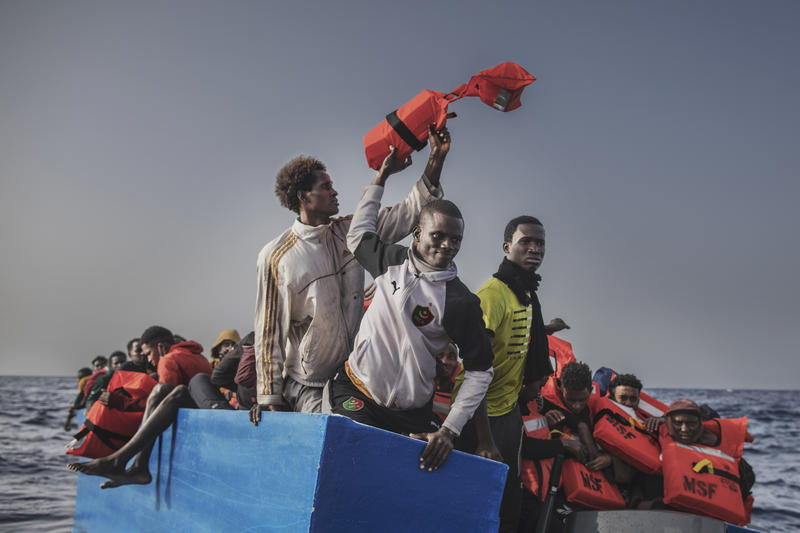
Sometimes governments reveal the power of images through their attempts to suppress them.
This truth has become evident again in the UK this week via debate on the Online Safety Bill. According to the UK government, this bill is designed to protect users from harmful social media content by making technology companies and their chief executives liable for the content they publish.
An amendment to the bill–driven by the Conservative MP for Dover, Natalie Elphicke–proscribes some visual content that shows people crossing the Channel in small boats in a “positive light” as illegal and something that all tech platforms must proactively prevent from reaching users.
Elphicke said in a BBC radio interview that she wanted to have videos “promoting, glorifying, encouraging” cross-channel crossings taken down to “stop the ‘TikTok Traffickers’ who peddle their people smuggling criminal activity online…”
While dismantling the ability of people smugglers to attract business via videos on social media is a worthy goal, potentially censoring visual content that humanizes refugees for UK audiences is wrong.
The Conservative government in the UK demeans people arriving in England by boat as illegal migrants and intemperately describes the rising numbers as an “invasion.” However, this extension of their hostile environment policy runs counter to many facts: it is not illegal for people to travel by any means to lodge an asylum claim; people only risk their lives on ill-equipped dinghies in the world’s busiest shipping lanes because official, safe routes to claim asylum have been deliberately closed off to most nationalities (contrast the situation of Afghans versus Ukrainians fleeing conflict and attempting to come to the UK); and when asylum applications are finally processed, more than 60% of those are approved in the first instance (with many others approved after appeal).
The othering of individuals fleeing persecution and war – especially those denied safe passage to make legitimate asylum applications – is a staple of governments prioritizing borders, national identity, and sovereignty over human rights. The current UK government is beating this exclusionary drum often and loudly. In this respect, it closely follows the script of Australian governments–both conservative and Labor–over the years.
Since the early 2000s, both major political parties in Australia have portrayed the issue of asylum seekers as one of border protection and sovereignty. And government-led visual strategies have been at the heart of such political campaigns. This was revealed in a detailed Australian Senate inquiry following the Tampa incident of 2001. (This section is taken from Roland Bleiker, David Campbell, Emma Hutchison & Xzarina Nicholson (2013), “The visual dehumanisation of refugees,” Australian Journal of Political Science, 48:4, 398-416).
The Senate report revealed a tightly controlled approach to the issue of “boat people”–asylum seekers making the long and arduous sea voyage to northern Australia in rickety vessels–including policies that meticulously regulate “what images could be collected and who could provide public information.” There were explicit governmental directives not to “personalize” or “humanize” the issue of asylum seekers. A key reason for the ensuing tight control of photojournalists was “to ensure that no imagery that could conceivably garner sympathy or cause misgiving about the aggressive new border protection regime would find its way into the public domain.”
These policy documents suggest explicit knowledge of how specific images can generate either compassion or fear in viewers. For example, close-ups of asylum seekers are recognized as humanizing, whereas pictures taken from a distance are not. The latter was better suited to capitalize politically on widespread popular fears of uncontrolled migration threatening Australia.
Governmental control over images of asylum seekers in Australia intensified in the decade after the Tampa affair. In October 2011, the Department of Immigration and Citizenship announced a new media policy. Designed to control media access to asylum seekers, a crucial part of this policy was to regulate the use of images, mainly to prevent journalists from showing the faces of asylum seekers. The policy was crystallized in a ‘Deed of Agreement’ meant to protect asylum seekers and their families from possible retaliation at home.
Such privacy concerns are legitimate and shared by refugee organizations, which urge photojournalists to proceed with caution and sensitivity when publishing images that may identify individuals. Nonetheless, journalists who visited detention centers, for instance, were at the “absolute discretion” of officials. Each photograph they took was carefully controlled and filtered using three options: “pixelate/mute/delete.”
These policy guidelines gave Australian officials great control over how asylum seekers are publicly visualized. Moreover, the guidelines were politically significant: they controlled the relationship between images, emotions, and public perception of and reaction to refugee crises.
UK and Australian politicians have demonstrated an acute awareness of the linkages between images, emotions, and public perception through their legislative proposals and policy guidelines.
Similarly, refugee advocates and visual journalists recognize the power of visuals when they highlight the importance of portraying individuals and human beings. Showing their faces may not be sufficient–portraits will not change the world, and the broader stories need to be heard–but it is necessary. And any limits on that ability to see must be resisted.
In November 2021 we had a detailed conversation about the politics of representing refugees – check out the video Representing Refugees – Telling the Story of Migrants Coming to Europe.
